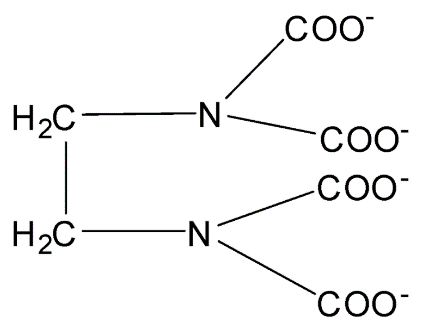
EDTA is a multidentate ligand. Its denticity or multiplicity is ………………………
Answer
528.6k+ views
Hint :Ligands are the donor atoms, molecules or anions which donate a pair of electrons to metal atoms or ions are called ligands. In EDTA there are four Oxygen atoms and two Nitrogen atoms. Nitrogen and oxygen both have lone pairs to coordinate with the central atom in the complex compound.
Complete Step By Step Answer:
We know that Denticity refers to the number of donor groups in a particular ligand that transfer lone pairs to the central atom and bind it in complex compounds.
In most of the cases, only a single atom in the ligand binds to the metal, then the denticity equals one, and the ligand is said to be monodentate or bidentate.
Ethylene diamine tetra acetate ions (EDTA) form a complex with metal ions in coordination compounds. Denticity refers to the number of donor groups that are attached to the ligand to participate in forming coordinate bonds with the complex compounds.
EDTA is a type of ligand in which donor atoms contain lone pairs of electrons and can donate electrons to positively charged central atom species to form complex compounds. EDTA is a multidentate ligand. Its denticity (multiplicity) is 6.
In EDTA, there are four Oxygen atoms and two Nitrogen atoms. Nitrogen and oxygen both have lone pairs to coordinate with the central atom in the complex compound. EDTA is also used extensively in the analysis of blood. It is an anticoagulant for blood samples in the field of medicine.
Structure of EDTA:

EDTA is a polydentate ligand have flexidentate character in which four Oxygen atoms and two Nitrogen atoms form coordinate bonds with the central metal atom or ion. Therefore, there are six donor atoms present in EDTA.
Hence, EDTA is a hexadentate ligand. Its denticity or multiplicity is 6.
Note :
The coordination compounds are of great importance and are widely present in minerals, plants and animals and are known to play many important functions in analytical chemistry, metallurgy, biological systems, industry and medicine. EDTA is used in treatment of lead poisoning. EDTA which is a hexadentate ligand also acts as tetradentate or pentadentate in certain complexes.
Complete Step By Step Answer:
We know that Denticity refers to the number of donor groups in a particular ligand that transfer lone pairs to the central atom and bind it in complex compounds.
In most of the cases, only a single atom in the ligand binds to the metal, then the denticity equals one, and the ligand is said to be monodentate or bidentate.
Ethylene diamine tetra acetate ions (EDTA) form a complex with metal ions in coordination compounds. Denticity refers to the number of donor groups that are attached to the ligand to participate in forming coordinate bonds with the complex compounds.
EDTA is a type of ligand in which donor atoms contain lone pairs of electrons and can donate electrons to positively charged central atom species to form complex compounds. EDTA is a multidentate ligand. Its denticity (multiplicity) is 6.
In EDTA, there are four Oxygen atoms and two Nitrogen atoms. Nitrogen and oxygen both have lone pairs to coordinate with the central atom in the complex compound. EDTA is also used extensively in the analysis of blood. It is an anticoagulant for blood samples in the field of medicine.
Structure of EDTA:

EDTA is a polydentate ligand have flexidentate character in which four Oxygen atoms and two Nitrogen atoms form coordinate bonds with the central metal atom or ion. Therefore, there are six donor atoms present in EDTA.
Hence, EDTA is a hexadentate ligand. Its denticity or multiplicity is 6.
Note :
The coordination compounds are of great importance and are widely present in minerals, plants and animals and are known to play many important functions in analytical chemistry, metallurgy, biological systems, industry and medicine. EDTA is used in treatment of lead poisoning. EDTA which is a hexadentate ligand also acts as tetradentate or pentadentate in certain complexes.
Recently Updated Pages
Why are manures considered better than fertilizers class 11 biology CBSE

Find the coordinates of the midpoint of the line segment class 11 maths CBSE

Distinguish between static friction limiting friction class 11 physics CBSE

The Chairman of the constituent Assembly was A Jawaharlal class 11 social science CBSE

The first National Commission on Labour NCL submitted class 11 social science CBSE

Number of all subshell of n + l 7 is A 4 B 5 C 6 D class 11 chemistry CBSE

Trending doubts
Differentiate between an exothermic and an endothermic class 11 chemistry CBSE

10 examples of friction in our daily life

One Metric ton is equal to kg A 10000 B 1000 C 100 class 11 physics CBSE

Difference Between Prokaryotic Cells and Eukaryotic Cells

State the laws of reflection of light

Explain zero factorial class 11 maths CBSE




